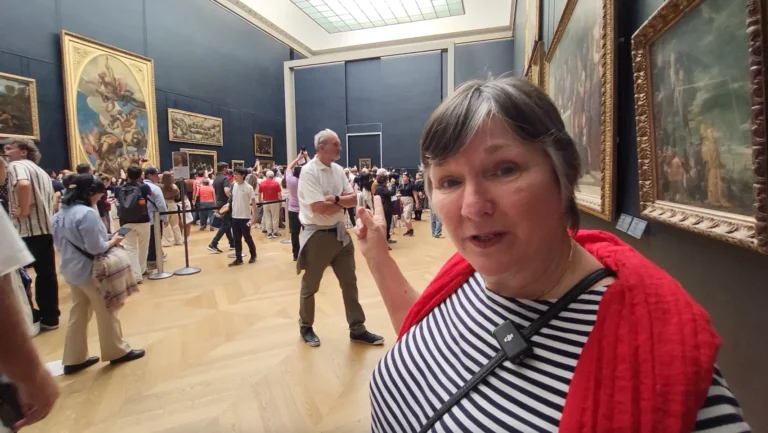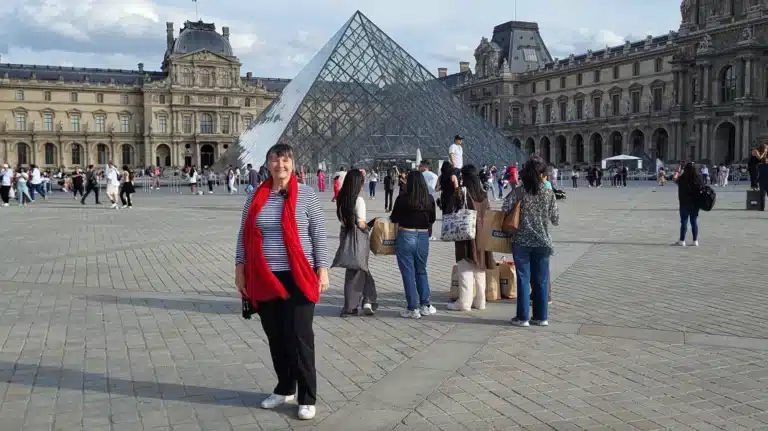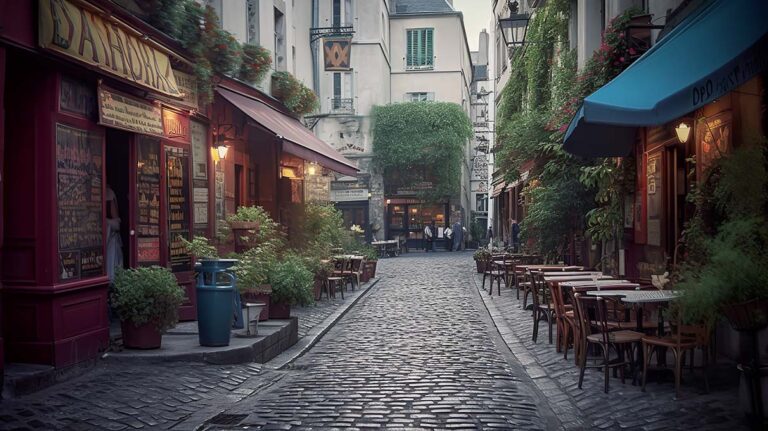Ride the Paris Metro Like a Local: Everything you need to buy metro tickets & passes, and get where you want to go
The Paris metro is an incredible transit system, and often the fastest way to get almost anywhere in Paris, sans crazy traffic or surge pricing. But, with 141 miles of track and 308 stations, it may seem overwhelming to use. Not to worry! We’ll break it down for you. This guide will show you how the Paris metro system is laid out, how to buy tickets or a pass, what apps to use to plan your trip, and what to watch out for. We’ll even point out a few of the breathtaking stations you won’t want to miss. Ready? Allez! On-y-va!
How does the Paris metro system work?
The Paris metro system operates within the city limits of Paris. To get an overview of the system, start by looking at the Paris metro train map. This ingenious system is made up of 16 different lines, numbered from 1-14 (the other two lines have the word “bis” next to them, indicating that they are branch lines). The system is growing, too, with four new lines in development. So the metro you ride on this trip may be different the next time you visit.
Paris metro lines are organized by number and color. The direction that the line is traveling is indicated by a place name at the end of the line. Stops along the way are indicated by two different kinds of dots. A white dot means that the station is a transfer point where you can switch to other lines. A solid color dot means that the station is stand-alone, with no transfers available.
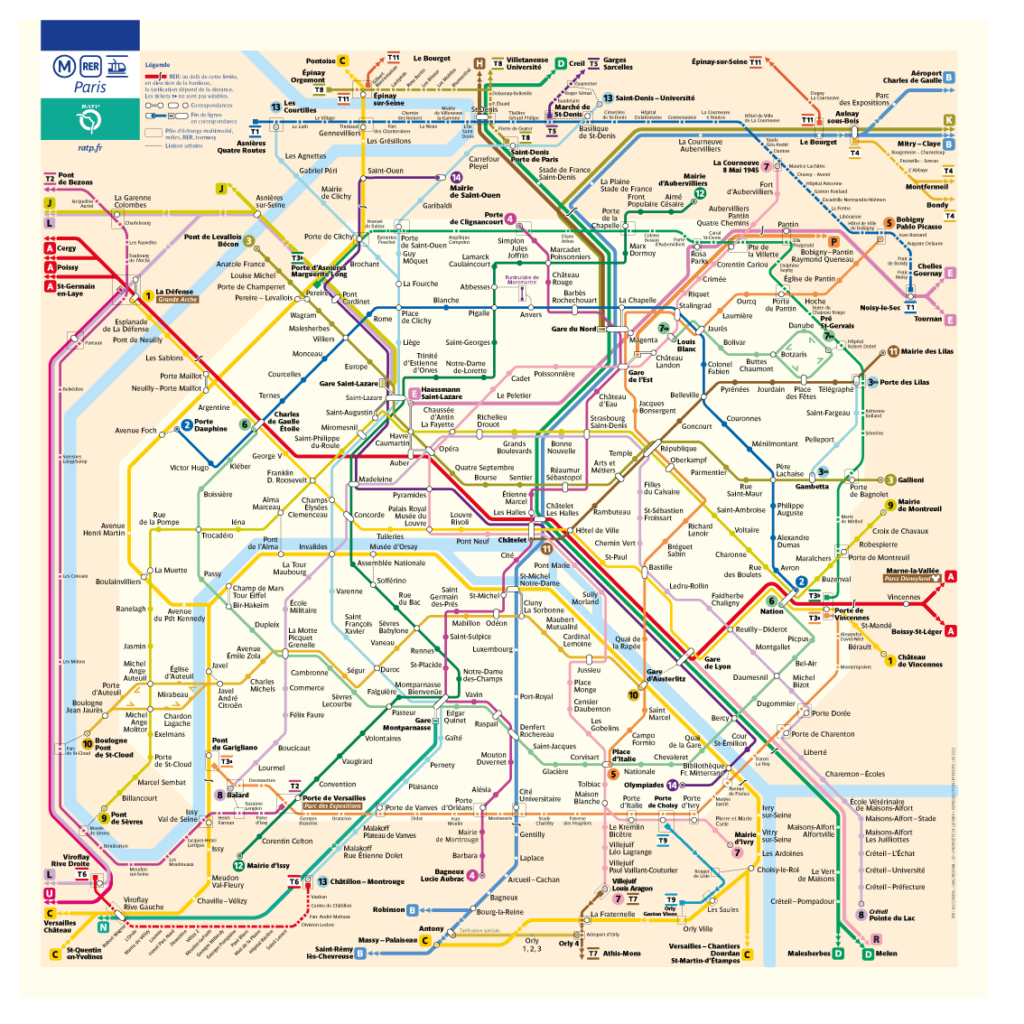
Look at a larger regional map of the Paris metro system and you’ll see that the area is divided into different zones. There are six in all. Zones 1-3 are the core of Paris proper, and zones 4-6 represent the suburbs that ring the city. For most Paris attractions, you won’t need to worry about zones. However, if you want to use the transit system to or from the airports, or to visit Euro Disney, Versailles or other attractions, then you’ll be crossing zones. This will impact the fare you’ll pay.
Two other adjacent systems you’ll want to know about:
- RER trains, indicated by letters, run from the city center to the suburbs, airports, Versailles and Euro Disney.
- Trasillien and TER trains are commuter trains that serve the broader region of Île de France, where Paris is located. You get these at Paris’ major train stations.
???? Download Free Metro Maps from Official Website:
???? METRO Map: https://www.ratp.fr/en/plan-metro
???? RER Map: https://www.ratp.fr/en/plan-rer
How do I purchase Paris metro tickets or passes?
Buying tickets for the Paris metro system is easy. There are two ways to do it. First, let’s look at buying metro tickets in the station. You can buy a single ticket, multiple tickets, or passes either from a machine or at a booth with an attendant (though not every station has a station attendant). You can also purchase a Navigo Easy Card, which is like a credit card that you can load with multiple rides and use throughout your trip.
Two things to watch out for if you buy your Paris metro tickets in the station.
- Scammers may try to sell you used tickets, so only purchase from the machines or an attendant in a booth.
- Pickpockets target popular metro stops, so keep your purses and backpacks zipped. In this video, we’ve shared our 10 best tips to protect you from pickpockets. But don’t worry, the chances of having to deal with this are very small.
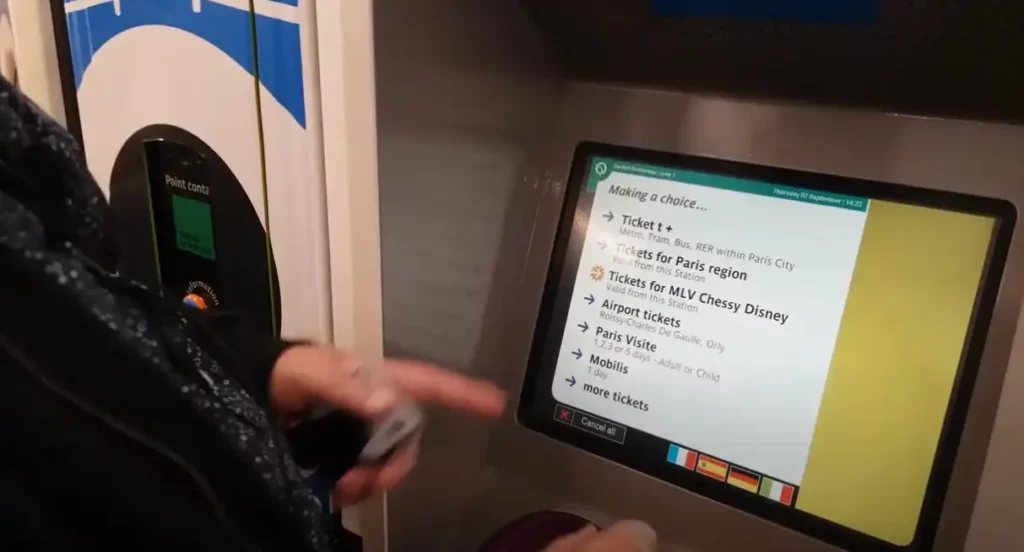
You can also buy tickets online through an app, like Bonjour RATP (see below). This will let you either load or top off your Navigo card, or you can even use your phone as your ticket. The nice thing about buying online is that you don’t have to get your wallet out in the station – you just breeze through.
You have a few different ticket options to choose from, so select one that works for your plans.
Single use tickets for the Paris metro are called T+. You can purchase these from the machines or booths in the station. Be sure to carry the ticket with you until you exit at the end of your ride, in case you get approached by an agent. If you don’t have your ticket, you could be fined. This happens rarely, but why risk it!
Daily and weekly passes are also available:
- Daily: The Navigo daily pass might be right for you if you plan to use the Paris metro system more than 5 times on a single day. Prices vary depending on how many zones you expect to travel through. For most people visiting for a few days, this is probably not the most economical way to use the metro, but if you have just one day and want to see as much as possible, it could be a good option.
- Weekly: The Navigo weekly pass is worth a look if you’ll be using the Paris metro a lot over a weeklong visit to Paris. But you should know that the pass starts on Monday and ends on the following Sunday, no matter what day you purchase it. So if you arrive on Wednesday, it will only work through the following Sunday. However, if you arrive early in the week, it is a good way to save some money on your metro costs. There are different prices depending on the zones you’ll be traveling through so consult the website for current pricing options
???? METRO & RER Pricing: https://www.ratp.fr/en/titres-et-tarifs
How do I plan my trip on the Paris metro?
All right! You have your tickets, now it’s time to start exploring the City of Light! Where do you want to go? Chances are the Paris metro system will get you there. But it helps to plan your metro trip ahead of time. We use these apps to do that ourselves:
- Google Maps: You probably already have this on your phone and know how to use it. The Paris metro system is already in it, so simply enter your desired destination and it will show you the best route, including how far you’ll have to walk, any transfer points, and an estimated time of arrival.
- SNCF Connect: This app is from the state-owned French rail system. It’s very comprehensive, and will show you all the possible ways to get to your destination. This one is especially good if you will be planning excursions to places outside Paris as well as your Metro trips.
- Bonjour RATP: The official app for the Paris Metro system, this app includes trip planning and has very good maps. You can use it to top off your Navigo pass, and it even includes details like how crowded your train is likely to be at a given time.
And here’s a little insider tip for you: Just four lines will get you to most of the main sites you’ll want to visit in Paris. Get to know these and you’ll be navigating the system like a pro!
- Line 1 goes east to west across Paris
- Line 4 goes north to south
- Line 8 goes from southeast Paris to the southwest
- Line 12 is another north/south line
How do I get around on the Paris Metro?
There are three key things you need to know to use the Paris metro system:
- The line number, 1-14 (and the color if you’re visually oriented).
- The end of the line for the direction you want to travel, because this is what the signs inside the metro system show. This will be a place name.
- The stop where you want to get off.
For example, if you’re at the Palais Garnier (the beautiful opera house), and want to visit the Eiffel Tower, you will take line 9 in the direction of Pont du Sèvres, and get off at the stop called Alma-Marceau, and then walk from there. If your trip involves a transfer to a different line, you’ll also need to know the end point direction and stop name for the new line as well. Any of the apps mentioned above will give you this, so don’t worry!
A few other things are helpful to know about moving around inside the Paris metro system. First, it’s a lot of walking, and often there are many stairs, too. We recommend wearing comfortable shoes because you will get your steps! And a pro tip on this is that some of the apps show you how far you’ll have to walk to get to the stop and your final destination, and even inside the system. This is especially helpful if you or someone you’re traveling with has mobility concerns.

Trains run frequently, so you don’t have to run to catch one. On each platform you’ll see a board that shows how long until the next train arrives, and more often than not, the trains arrive right on the dot.
Inside the trains there will be a map of the line with the stops and any transfer points identified so you can follow along.
You’ll want to know the hours for the Paris metro system. During the week, the Paris Metro is open from 5:30 AM until 1:15 AM; on the weekends, until about 2:15 AMFinally, at any given time, the Paris metro system may experience slow downs, repairs, or stoppages. Most apps will indicate if this is happening, and you can also look at the RATP website for up to date information.
What are some of the most beautiful stations in the Paris Metro system?
Some Paris metro stations are real showstoppers when it comes to gorgeous design. It’s part of what makes Paris one of the most beautiful and beloved cities in the world. Let’s take a look!
Chances are, you’ve seen photos of the famous Art Nouveau entrances to some Paris metro stations. These go all the way back to 1900, when the system first came online. This being Paris, the city engaged artists and architects to design a system that was both functional and beautiful. Architect Hector Guimard designed the iconic Art Nouveau style entries and design elements that can still be found throughout the system. The Porte Dauphine entrance at the end of line 2 is one of the original 1900 entrances, as is the Abbesses in Montmartre on line 12. You can also see Art Nouveau elements at the Saint Michel station along line 4 in the Saint Germain area.

Other stops that are spectacular in their own way include the Louvre-Rivoli stop on line 1, which looks like the famous museum. On line 3, the Arts et Métiers stop is like visiting an undersea submarine straight out of a Jules Verne story, complete with copper walls and portholes. And the Concorde stop on line 12 features a modern art installation by Françoise Schein. It may look like a large word search game, but it’s really the text from the Declaration of the Rights of Man, one of the most important documents from the French Revolution.
No matter where you travel on the Paris metro system, you’ll find unexpected moments of beauty, enjoy great people watching, and, like a true Parisian, you’ll partake in a fast, efficient way to travel across this magnificent city.
These websites can help you plan your trip, see ticket options & prices, and learn about the Paris metro system:
- Île de France Mobilities – all your ticket & pass options
- RATP – information, updates, and trip planning resources from the Paris metro system
Paris Metro FAQ
Bicycles are not allowed during peak hours, and there are restrictions on bringing large items during crowded periods. However, during off-peak hours, you can bring your bicycle for an additional fare, and large luggage is generally permitted.
Yes, there are some unwritten rules. Parisians generally appreciate a level of quietness in the Metro, especially during rush hours. It’s also customary to let passengers exit the train before entering and to give up seats for elderly or pregnant individuals.
The Paris Metro is continuously improving its accessibility features for passengers with reduced mobility. Some stations are equipped with elevators, ramps, and tactile pathways. Check online for station accessibility information and plan your route accordingly.
If you’d like to learn more about the Paris metro system, we recommend these videos:


